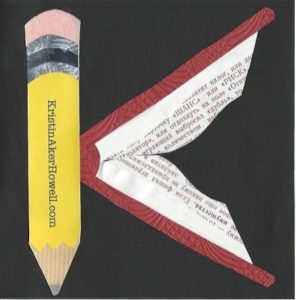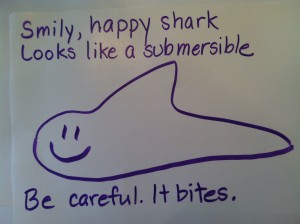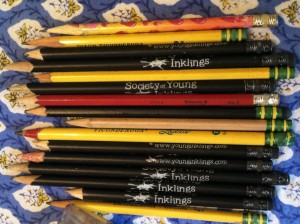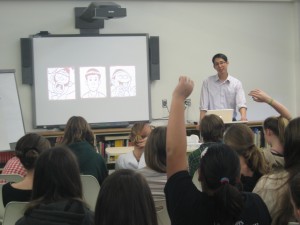Plant a Seed
June 12, 2013 | Posted in Blog: Story Stories, teaching | By Kristin
Comments Off on Plant a Seed
A seed is full of genetic material. It contains a bit of food to get the next creation growing.
Without a seed, a writing class is a writing club.
After the fun, after the friends, a writing class needs a seed: a small, inspiring, critical component. I like to read a story. Usually I ask a question – or introduce an idea – before I read a story. That question – or idea – is the seed.
Before Audrey Wood’s Heckedy Peg we talked about foreshadowing. As I read the story to a group of second and third graders we discussed how the items children needed from the market foreshadowed what they became at the witch’s house, which foreshadowed how their mother saved them.
I asked: Did you foreshadow something in your story?
I never point out a lack of something in a child’s story. I know, from writing my own stories, that it is far too easy to shut down the creative process. I learn more by seeing new things in other stories. When I’m really lucky, I might make a connection to my own writing. When I’m fortunate as a teacher, one of my students might find his own connection.
After reading Heckedy Peg, I said, “Sometimes we give ourselves a gift at the beginning of our stories we forget. Maybe if we have trouble with an ending, we can re-read the beginning we have already written.”
“Oh!” said a second grade student, “I just thought of an idea for my story.”
That is my greatest hope for students when we read and discuss literature: that they will make a connection to their own writing. And, that this connection will help them to grow.
We Are Not Alone
June 10, 2013 | Posted in Blog: Story Stories, teaching | By Kristin
Kids who write need friends who write. Every writer needs friends. We need to be heard. Writing friends are special because they listen to our stories.
Friends believe us. They know the names of our characters, the places we’ve created and the challenges we face. They ask us questions. They cheer for us and laugh alongside us. They remind us about what we have forgotten.
I love to see kids sit next to each other in writing class. They don’t always read each other’s journals, but they frequently discuss their stories together.
Often, there is laughter.
It is lonely to make a new world. When we invite a friend – a real person – into this new place, we know we are not alone. Our friend has entered with us. She will help us get this place ready for other visitors: which is our greatest dream and biggest fear.
In writing class, many kids are ready to share their work immediately – sometimes we read to everyone at the end of the day – and some kids may take almost a year until they find someone they trust, or are ready to read to the group.
When a writer is afraid, often her friend will read her work aloud for her. This way she knows her work matters to us.
Sometimes our writing friends are the only ones who demonstrate that our work matters. Writing friends have many important jobs.
Writing friendships are delicate because writers tend to be sensitive. Something intended as an observation may be felt as a criticism. When spoken by one we trust, however, just such an observation can lead to growth. For example, a fourth grade student recently commented to another: “Your main characters are always girls.”
Instead of feeling hurt, this writer took the challenge. She wrote her next story outside of her comfort zone, with a fascinating new premise. The class begged to hear sections of her new story read aloud each week. When friends believe in us enough to listen carefully and tell the truth, everyone benefits.
We don’t need 500 friends. Anyone – kids or adults – would be lucky to have one or two true friends.
Let’s Mandate Fun
June 7, 2013 | Posted in Blog: Story Stories, teaching | By Kristin
Comments Off on Let’s Mandate Fun
Creating something from nothing. Marjorie Frank calls it “romance.” Naomi Kinsman Downing calls it “play.” Some call it “foreplay.” No matter what you call it, it’s an essential start to the writing process.
One must get one’s creative juices flowing, so to speak. But I’ll stick with the PG version: Fun. Writing starts with fun. If you’re not having it, most likely you’re staring at a blank page or computer screen.
The same goes for teaching a writing class. Kids can’t write if they are not having fun. If the kids aren’t having fun, you’ve got a class full of kids ripping up paper, playing light sabers with pencils, crawling under desks, or using up all the anti-bacterial gel.
In short, kids will make their own fun. And it won’t be fun for you.
Fun is paramount. If I could, I’d make fun mandatory. For teachers. Forget the kids, man. If we’re having fun, so are they.
Naomi Kinsman Downing, Founder and Creative Director of Society of Young Inklings, articulates it this way.
“The freedom associated with letting go, being silly, breaking patterns, is the very thing most likely to bring new ideas and insight. Play isn’t trivial. It’s vital.”
She’s right. How often have you been unable to solve a problem as you sit for hours at your computer? Miraculously, when you release your mind from it – sew, garden, shower, feed the kittens – a brand new idea may come.
Play frees. We need fun to create. The first book I bought about writing was called “If You’re Trying to Teach Kids How to Write You Gotta Have This Book.” It was written by Marjorie Frank and published in 1979. I kept it on my desk when I began teaching over twenty years ago. I still have it on my desk now.
In her chapter titled “Romance,” Frank say this:
“Experiences – with self, with others, with literature, with arts, are the catalysts that ignite expression…PLEASE, don’t ask kids to write without giving them some input!…SOMETHING romantic needs to proceed the writing assignment: some happening that jars loose the poetry inside their heads and sets free a flow of new ideas.”
As a teacher, mostly I can figure out what will be fun for kids. Usually its what’s fun for me: playing a silly game, reading a book, making detailed observations of art or life, experiencing art, or sharing interesting information. Today we drew silly pictures – starting with a scribble – then wrote haikus together. We had fun trying to make sense of our pictures, within the syllable count of haiku.
When an activity is no longer fun, sometimes a kid will ask, “Can we just go write?”
I’ve never said, “No,” to that question. Sometimes, writing is more fun than a game, or a story, or whatever else I’ve brought for the day. Sometimes, that question means the game, or story, or photo did its job.
Each writing session is a chance for joy. If you’re not having fun while you’re teaching writing, stop. Do something that sounds fun. To you. Its vital.
It should be mandatory.
How to Learn How to Write
June 6, 2013 | Posted in Blog: Story Stories, teaching | By Kristin
Comments Off on How to Learn How to Write
For three years, I’ve been teaching writing to kids all around Silicon Valley. My students have ranged in age from five to fourteen. I’ve also spent a good amount of time – two years – watching adults learn how to write, since I earned my MFA in Writing for Children and Young Adults.
You could say I’ve spent my last five years learning how to learn to write. When I tell people in casual conversations I am a Writer and a Writing Teacher, I often get a fake smile in return, or a more honest, “I always hated writing.”
Lots of people of all ages say they dislike writing.
However, over the last few years of writing classes with kids – and adults – that has not been my experience. Once people have the opportunity to write freely, they often love it.
Over my last few years, I’ve seen Kindergarteners run to class, second graders write novellas, fourth graders outline and write multiple novels, and teenagers suggest meeting together to write – with their free time.
When writing class is fun, anything can happen. Kids can wish everyday were writing class and they write every night instead of watching TV. A second grader can write a true story about a friend who survived a frightening trip to the hospital. A fourth grader can go from weeping at the sight of a notebook to claiming writing as her favorite subject.
Third graders can create entire worlds. Kindergarteners can imagine visiting the moon and Mars. First graders can write a story so sad and scary it will haunt your dreams. Fourth graders can create intricate fantasy worlds, characters who inhabit them, share those worlds and characters with each other, and write highly entertaining stories consistent with those settings. Teenagers can write poetry, realistic fiction, fantasy and science fiction that will make you laugh and think; worthy of publication. This world is full of young and gifted writers.
And it’s easy to nurture them.
First of all, you’ll need a lot of pencils.
After that, I think it boils down to four things pretty simple things: fun, friends, seeds and cookies.
I’m taking the pencils for granted. Those would be element number five. My next four days of blog posts will be dedicated fun, friends, seeds and cookies. I don’t have much to say about pencils, other than: Keep them out of your neighbor’s eye, please.
Gene Luen Yang Visits Hillview
February 28, 2013 | Posted in Blog: Story Stories, teaching | By Kristin
What is a soul? How much can people change? How can a person’s family be oblivious to his complete transformation?
These are questions Hillview seventh graders asked recently while reading Gene Luen Yang’s Printz-winning graphic novel American Born Chinese.
The novel was based on Yang’s experience growing up in the Bay Area. Tuesday, he spoke with the students about his novel. Once they heard about the origins of the three story lines in the book, their questions transformed.
They got personal.
Especially when they discovered that the character Jin Wang had a childhood similar to Yang’s. Did you grow up in the Bay Area? Did that really happen to you? Did someone really say that to you? Did you do something like that?
Yang’s honest answers helped these seventh graders understand how good fiction is created: from real experiences. Yang also shared the origins of the other complex story lines in American Born Chinese.
Yang shared the many iterations of the popular character The Monkey King. As a boy, he heard stories about The Monkey King practically nightly. Yang’s own Monkey King is shoeless; a difference based on his own childhood conversations with his mother – and important to the book.
The third story line – that of Chin Kee – raised the most questions as the students read the book. This character also originally caused the book’s exclusion from some bookstores. However, once Yang wrote an essay describing the origins of Chin Kee – and people had time to read through American Born Chinese – the novel came to be embraced. Chin Kee is an amalgamation of the stereotypes with which Yang was surrounded. As Yang told the seventh graders, “If you don’t accept your heritage, you end up becoming a stereotype.”
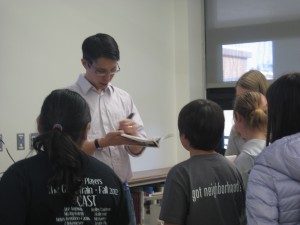
Yang signs autographs
At the end of his presentation – and at the close of school – Yang was surrounded for more gracious Q & A and autograph signing. It didn’t hurt that his most recent books were Avatar.
The program, Author Author, was funded by a Jeanie Ritchie Grant from the Menlo Park-Atherton Education Foundation and sponsored by Hillview librarian Tracy Piombo. Kristin Aker Howell works for the Society of Young Inklings.
